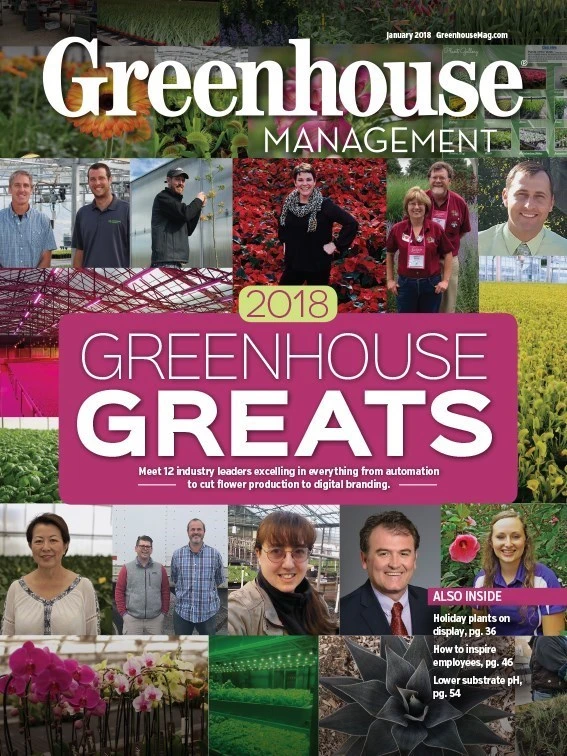
It may be exciting for horticulturists to know that some crops have more chromosomal sets per cell than they — humans — do themselves, making them feel humble in the face of plants they love.
Roses, chrysanthemums, lilies, lantanas, potatoes, sweet potatoes, yams and coffee: These crops are polyploids, meaning they contain multiple sets of chromosomes in each of their cells, as opposed to diploids, which contain only two sets. Since the early ’90s, Dr. David Bryne, professor and Basye Endowed Chair of Rose Genetics at Texas A&M University, has bred roses, and has been simultaneously impressed and perplexed by the polyploids’ complexity.
Breeders of ornamental crops often increase ploidy levels to scale up cells and flowers, and subsequently intercross them, Byrne says. But because of their additional sets of chromosomes, polyploids are more difficult to breed and perform genetic analysis on than diploids. “We’re getting all these genomic tools and molecular tools and markers, and we don’t necessarily have the computational tools to work with them efficiently,” Byrne says.
So Byrne has decided to assemble a global community, made up of four teams with focuses of breeding, genomics, genetics and analytics, to chart the best path forward in analyzing and breeding polyploids. Putting to use a $47,000 grant from the United States Department of Agriculture-National Institute of Food and Agriculture, Byrne is leading the meeting, “Tools for Polyploids,” Jan. 11-12, 2018, in San Diego. It will bring together about 40 academics, and about 10 professionals who work on the private commercial side of genomics and genotyping.
_fmt.png)
Riddled by roses
Through his experience working with roses, Byrne has targeted disease resistance in black spot, Cercospora and rose rosette, but much of his genetics has been on diploid roses. Approximately 80 percent of cultivated roses, he says, are tetraploids, meaning they have four chromosomal sets, and some are triploids, with three sets. (Both tetraploids and triploids are types of polyploids. There are also hexaploids, with six sets, octoploids with eight sets, and so on.)
Scientists throughout the United States and across the world have been working with polyploids, Byrne says, but many of them have not consulted with each other on how to work with polyploid crops.

“I was encountering this mountain in front of me saying, ‘We don’t always have the tools to analyze all these tetraploid genetics,’” Byrne says. “It dawned on me that they’re doing [work] like this in potatoes, they’re doing some in roses in The Netherlands and Scotland, and mainly potatoes — a little blackberries, a little chrysanthemum and sweet potatoes,” Byrne says. “I said, ‘It would make a lot of sense, since there’s scattered work out there, to try to put it all together,’ because I needed the help.”
The team approach
As the meeting nears, Byrne has met about a quarter of the scientists who will be there. The rest he has spoken to through email, or they were recommended by his colleagues. “They’ve said, ‘You should contact him because he’s doing such and such,’ or, ‘Contact her because she’s doing such and such. And bring them so we can all talk together,’” he says. “It’s been a fun process just finding people.”
Much of the work that Byrne hopes to achieve at the meeting addresses the difficulty of using existing computational methods to analyze the additional chromosomal sets of polyploids.

The group will also draft a white paper, and Byrne hopes to get it published. “I’m hoping that is going to be the basis of the grant proposal, too, because I’ll be hoping to find some additional funding,” he says.
Byrne aims to create four or five breeding programs, and the genomics, genetics and analytics teams will go back and forth with the breeders. “Say we work on potatoes and, let’s say, blackberries and blueberries and roses,” he says. “They develop a technique, and they try it in all these four crops to make sure that it works on everything — and we’d probably have to have a hexaploid in there because all those are tetraploids.”

Explore the January 2018 Issue
Check out more from this issue and find your next story to read.
Latest from Greenhouse Management
- 2025 Proven Winners Horticulture Scholarship applications now open
- How to improve inventory and shipping management in the greenhouse
- Leading Women of Horticulture: Anna Ball, Ball Hort, and Terri McEnaney, Bailey Nurseries
- GM CEA HERB Part 2: A guide to increasing the sowing density of culinary herbs
- GM CEA HERB Part 1: Best practices for producing culinary herbs in controlled environments
- USDA fires experts on invasive pests, including Asian citrus psyllid, chilli thrips
- CEA Alliance celebrates bipartisan introduction of Supporting Innovation in Agriculture Act
- Dümmen Orange North America celebrating 25th anniversary in 2025






